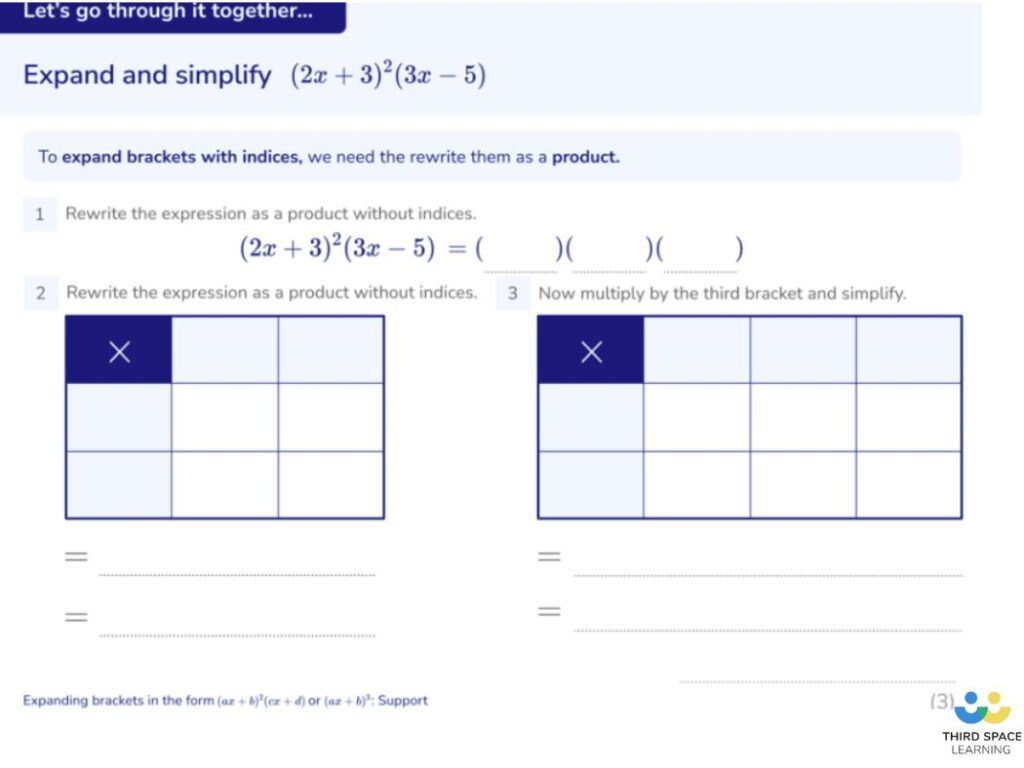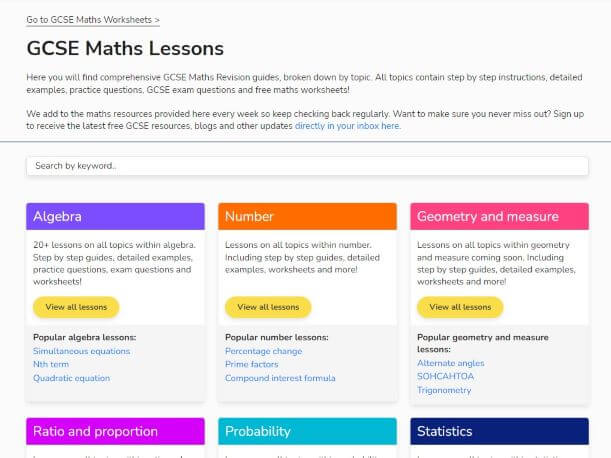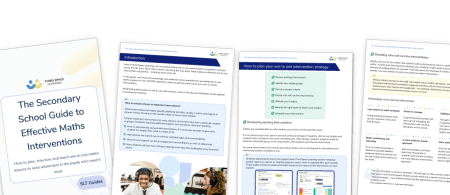GCSE Intervention Strategies: Making The Most Of Your Extra Lessons
Given the disruption to children’s schooling in recent years, it’s not surprising that larger numbers of secondary schools than ever are looking at implementing additional GCSE intervention strategies for their Year 10 and 11 students. Here we look at some of the options available to you and how to get the best out of your GCSE interventions, particularly in maths.
GCSE MATHS 2024: STAY UP TO DATE
Join our email list to stay up to date with the latest news, revision lists and resources for GCSE maths 2024. We’re analysing each paper during the course of the 2024 GCSEs in order to identify the key topic areas to focus on for your revision.
Thursday 16th May 2024: GCSE Maths Paper 1 2024 Analysis & Revision Topic List
Monday 3rd June 2024: GCSE Maths Paper 2 2024 Analysis & Revision Topic List
Monday 10th June 2024: GCSE Maths Paper 3 2024 Analysis
GCSE 2024 dates
GCSE 2024 results (when published)
GCSE results 2023
Learning loss – the latest estimates
The pandemic and resulting school closures have significantly affected pupils’ learning in maths. Research published by the EPI in January, Spring and then end of the Summer Term showed:
- By the end of the spring term (March 2021), average learning losses were 3.4 months in maths and 2.2 months in reading for pupils in primary school.
- By the summer term (June 2021), losses had recovered to 2.2 months in maths and 0.9 months in reading for pupils in primary school.
- Secondary school pupils did not recover as much as pupils in primary schools. In reading, secondary pupils saw losses of 1.5 months of learning by the autumn term (2020), but by the summer term (2021), losses were still 1.2 months.
- There is also some indication of regional differences with pupils in the North East and Yorkshire and Humber experiencing the greatest impact – and indeed struggling to make it up even after time at school.
The Secondary School Guide to Effective Maths Interventions
Find out how to plan, manage, and teach one to one (and small group) math interventions in Key Stage 3 and GCSE.
Download Free Now!The picture for disadvantaged pupils was the most severe: even after time back in school in spring learning losses for disadvantaged pupils were 4.2 months in maths and 2.7 months in reading for primary. Primary pupils made up some of these losses but:
- disadvantaged pupils in secondary schools had fallen further behind by the summer. In reading, losses in the autumn term (2020) were 1.9 months for secondary disadvantaged pupils. By the summer term (2021), they rose to 2.4 months.
- It is expected that the picture in maths will be worse given findings previously that maths was ‘worse hit’ in terms of learning loss.
Inevitably effects have been greatest on those pupils commonly identified for additional support – for example, pupils receiving free school meals, pupils with English as an additional language, and those with learning or support programmes in place.
Read more on this research here: Pupils progress in the 2020-2021 academic year
Maths attainment gap grows ever wider
If we look specifically just at mathematics, the picture is even bleaker. A report by the Centre for Education and Youth (CfEY) has warned that pupils in the UK are reaching a crisis point in their maths learning; not only has maths been the most affected subject in terms of post-pandemic learning loss, but maths is also the subject where the link between KS2 performance and eventual GCSE performance is the strongest.
This report also mentions that the solution likely to have the greatest impact is one to one tuition which we also look at below. One to one maths tuition can form part of your pupil premium strategy and funding can be used to help close the maths attainment gap.
Read more on this research here: A Space for Maths.
GCSE maths is still going ahead
Despite this picture from across the country, and after several years of disruption GCSEs are now pretty much back to normal. With internal resources stretched, and with additional catch up funding that was made available, many schools have been able to realised the benefits of additional GCSE intervention strategies to support students to make additional progress and succeed in their exams.
EFFECTIVE AND AFFORDABLE ONLINE MATHS INTERVENTIONS
Although there’s plenty of guidance here on what you should consider when setting up your own maths interventions, if you’re looking to outsource it Third Space Learning are the most experienced, effective and affordable of one to one maths intervention providers.
Take a look at the experiences of other schools and school leaders to see if we might be right for you.
READ MORE: Third Space Learning
Who: Identifying pupils for intervention
The first step as with any interventions is to identify which pupils to target. In this regard it’s probably ‘business as usual’. It is likely that the pupils who have traditionally always needed or been targeted with extra support will be the ones most affected by learning loss, but with the caveat that we might need to provide more intervention for more pupils than we usually do.
The standard systems already in place in schools should be suitable for the new academic year. These will probably include close monitoring of FSM, EAL, and SEN pupils for rapid intervention if necessary, and use of ongoing formative assessments in lessons or end-of-year assessments to identify pupils who are at risk of not achieving the grades they need.
As usual, it may be appropriate to target borderline grade 4/5 candidates as we draw closer to the exam period.
When developing your strategies for preparing your next cohort of foundation candidates we strongly recommend you review this indepth analysis of recent GCSE maths exams.
And here is your higher maths equivalent analysis
In addition to this, we also need to be aware of pupils who might need more targeted, shorter periods of intervention – for example, those who have perhaps missed entire topics due to isolation or illness. The usual routes for identifying these, such as teacher referral or formative in-class assessment, should be sufficient.
What: Considering the type of intervention
One-to-one tuition
In terms of impact, one-to-one tuition is the most effective; according to research from the Education Endowment Foundation (EEF), it delivers an additional five months of progress on average. The EEF suggests that “short, regular sessions (about 30 minutes, three to five times a week) over a set period of time (six to twelve weeks) appear to result in optimum impact”.
However, delivering this kind of intervention in a widespread way in a typical school environment is impractical, due to costs and timetabling constraints, particularly as the average school period is 60 minutes, and it would be unlikely that a pupil could be released from lessons up to five times a week.
It is these constraints that Third Space Learning removes by offering flexible online one to one tuition. that allows up to 30 students to receive targeted and individualised lessons at the same time with their own personal maths tutor. All they need is access to a laptop.

The EEF estimates costs of £700 per pupil for 30 hours tuition or £350 for 15 hours. During the National Tutoring Programme schools were able to get a reduction of 70% on normal tutoring costs from approved providers. Even now, as an approved provider, one to one online maths tuition with Third Space Learning is often half as expensive as that provided by other suppliers
Small group tuition
Evidence from the EEF indicates that small group tuition can be effective, although clearly the smaller the group, the better – the EEF suggests that a group size larger than six or seven results in a noticeable reduction in effectiveness. They further suggest that quality of teaching has a similar impact to group size – so it may be more effective to deploy a more experienced member of staff with a larger group, than it would a newly-qualified teacher.
The advantage of small group tutoring over one-to-one tuition in a typical school environment is one of cost – as group sizes increase, cost per pupil reduces. There is limited data on where the ‘sweet spot’ is in terms of group size, and this may vary depending on the pupils and teachers involved.
However in any group of pupils there is likely to be a great range in the learning gaps individuals have which won’t always be answered by teaching that follows a generic intervention programme.
Intervention must have – diagnostic assessment
A key part of any intervention is the diagnostic stage. At Third Space Learning, each pupil sits an initial diagnostic assessment before they start, which enables us to identify their precise knowledge gaps and misconceptions, and personalise their learning journey to suit. After each session, pupils answer a few short questions to ensure this learning journey is continuously adapting and reflecting up-to-date learning gaps.
And because tuition with Third Space Learning is one to one, every child receives an entirely personalised sequence of lessons.
One to one or small group tuition?
Traditionally small group tuition has been seen as a more affordable option for schools even despite the more ‘generalised’ approach of the intervention. However, Third Space Learning has always strived to be a much more cost effective solution by providing the quality of one to one at a price schools can afford.
And now with the further reduction that schools receive on the National Tutoring Programme, one to one tuition with Third Space is currently cheaper than small group tuition is ordinarily.
Peer tuition
This option is sometimes overlooked, but once set up, this can be an effective way of providing smaller interventions – for example, if a pupil has missed a lesson’s worth of content due to absence, or needs to secure understanding.
If your school operates a vertical tutoring system, this often happens organically – there is usually an older pupil available to explain things to a younger pupil. It can be a particularly effective use of sixth-formers (if you have them) with the bonus for them that it’s something else to add to their UCAS form or reference.
Even if tutor groups are arranged by year, it is possible to arrange a core group of older pupils to act as mentors, and deploy them during registration or pastoral time.
I would add a caveat that I’ve only found peer tuition effective in short bursts for small interventions – if there is deep conceptual misunderstanding going on, or a large chunk of work missed, pupils will need the support of a subject specialist.
Read more: EEF Learning and Teaching Toolkit has a breakdown of all interventions and their impact.
When: Fitting things into the timetable
Timetabling is always going to present an issue for school interventions. Creative use of registration or pastoral time is an effective strategy, although clearly this depends on the length of these periods and staff availability.
Morning interventions
At one of my previous schools, we ran an intervention session in the 25 minute morning registration slot, with three members of the maths department staff who had been freed up from pastoral duties for the year. Most pupils were rotated on a half-termly basis; in some circumstances, we saw pupils once a week for a check-in and review of that week’s work, whereas other pupils followed a more intensive program of basic skills work, and attended five times a week. As discussed above, this is also a great slot to fit in some peer tuition.
After school sessions
After-school sessions can also be an effective GCSE intervention strategy. One school I worked at ran two after-school sessions, one as an optional ‘drop-in’ session for pupils to self-refer if they felt they needed extra help, and the other a compulsory teacher referral session.
The drop in session was well-attended by Year 11s, particularly in the run-up to mock exams and in the Spring term – many of them wanted a quiet place to revise or complete homework, with the option to get immediate feedback and assistance from staff if they needed it.
The compulsory session was used for short-term interventions for pupils who had either missed content, or had been identified from their classwork or assessment results as in need of additional support. They would be asked to attend one, two or three sessions in a block, and specific work would be set by class teachers.
Out of timetable lessons
Sometimes, pupils are asked (or told!) to come out of timetabled lessons for additional support in core subjects – for example, PE is typically targeted. However, from experience, I’ve found that pupils who are very invested in the lesson they’ve been withdrawn from are more likely to arrive at their intervention session with a less-than-positive attitude.
Work with the individual pupils
Don’t assume that all pupils will have the same response to being removed from certain lessons. You might find six out of ten of the pupils identified for intervention are happy to come out of PE, but that you’ll get significantly better buy-in from the other four if they can do a session at another time.
How: intervention strategies to make your GCSE sessions effective
Regardless of the type of intervention chosen or when this occurs, there are a few strategies that I would suggest to make intervention sessions more effective.
1. Pupil buy-in
As discussed above, sessions are far more useful if pupils turn up with a positive mindset. If at all possible, they need to buy into the additional support, and not feel like the intervention is being ‘done to them’. Refocusing on the individual’s end goal can be incredibly useful – so needing to achieve a certain grade for their next steps/college course/A Level and so on.
At Third Space Learning we have tackled this head on by training our tutors in student-centred teaching. In clearly seeing the students at the heart of our intervention, our tutors focus on adapting to their needs and building rapport. This results not only in great engagement during lessons, but excitement to return the next time for another session.
2. Linking to class teaching
EEF research indicates that both one-to-one and small group tuition is most effective when carefully linked with classroom teaching. The most straightforward way to achieve this is with a curriculum plan that has all staff teaching the same topics at the same time; this way, the member of staff delivering the intervention session doesn’t have to spend time chasing round the rest of the department to find out what content needs delivering to which pupil. If this is not already the case for your cohort of Year 11s, it may be an option to consider.
Content on the Third Space Learning intervention can easily be linked to classroom teaching. During set up, three priority strands are selected for each pupil to focus on in both the diagnostic programme and teacher selection programme that we offer. In the teacher selection programme, lessons can be specifically selected each week, giving the flexibility to coordinate intervention sessions with what is being covered in class on a case by case basis.
3. Pupil ownership
As exam season gets closer, many Year 11s develop a better idea of their strengths and weaknesses, and can identify holes in their understanding. It might be appropriate at this time to set aside a small amount of time during each intervention session to work on a topic selected by the pupils – in a small group situation, this could be chosen on a weekly rotation. Encourage them to set small, manageable targets, such as completing some practice questions for the next session.
Tutors at Third Space Learning encourage students to really own their learning every step of the way. Each lesson finishes with a round up of what the student feels they have learnt that day: what was their biggest takeaway? What could they improve on? What have they excelled at? Tutors work together with their students to assess what their goals are and how they can achieve them. This could be to pass an upcoming exam, or simply to gain confidence in maths.
4. Intervention for all
While it is important that effective GCSE intervention strategies are put into place for those pupils who need them the most, it’s also important to be mindful of those who aren’t offered lots of additional support. Some pupils perceive it as unfair that they work hard and don’t get extra help, particularly if they also have the perception that some of those receiving intervention have a poor work ethic or don’t put as much effort in during class time. This is where relatively low-cost strategies such as an open drop-in session can be useful.
Third Space believes all pupils should have the opportunity to access extra support, not just those signed up for the intervention. That’s why you can find so many free maths resources on this website as well as a GCSE maths resource library full of GCSE maths worksheets and maths lessons which can be used to help any pupil prepare for their GCSE exams. Teachers can also find plenty of ideas for in class teaching and support on the Third Space Learning blog.
See also: Fluent In Five For Secondary

Planning for the year ahead
The primary goal for intervention for Year 11s for this term must be to hit the ground running with their GCSE intervention strategies already in place. It’s likely that your core group of pupils will have already been identified during face-to-face teaching sessions in the autumn term; organising something for them from the word ‘go’ will set the pace for the year ahead – possibly a programme along the lines of the EEF’s short, regular sessions, for the first half term initially.
For maximum impact, these sessions should link in with what’s being taught during class time; however, if this isn’t feasible, I’d suggest some intensive work on calculation, proportion, numeracy and problem-solving skills, particularly for Foundation candidates.
We must also be particularly proactive in identifying pupils with topic-specific GCSE maths revision gaps; they may be able to plug these gaps themselves with support and direction to appropriate resources, or they may benefit from a very short burst of additional tuition.
Finally, although I’ve focused almost exclusively on Year 11 in this blog post, almost all of what I’ve suggested is also relevant for Years 7-10. Where resources and funding allow, similar programmes for the other year groups could help to mitigate some of the lost learning over the last eighteen months.
Read more
DO YOU HAVE STUDENTS WHO NEED MORE SUPPORT IN MATHS?
Every week Third Space Learning’s maths specialist tutors support thousands of students across hundreds of schools with weekly maths intervention programmes designed to plug gaps and boost progress.
Since 2013 these personalised one to one lessons have helped over 150,000 primary and secondary students become more confident, able mathematicians.
Learn how we can teach multiple pupils at once or request a personalised quote for your school to speak to us about your school’s needs and how we can help.





